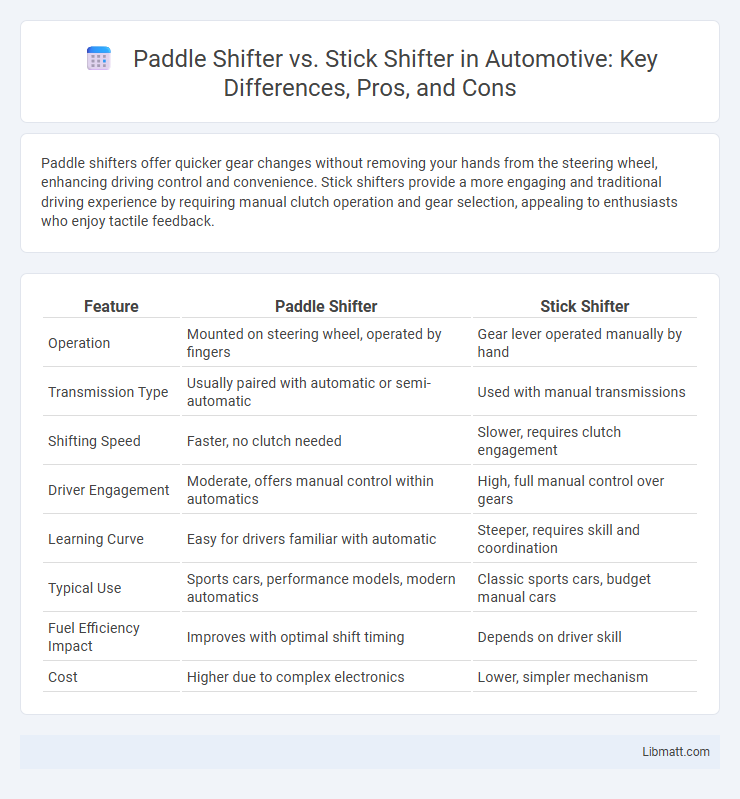Paddle shifters offer quicker gear changes without removing your hands from the steering wheel, enhancing driving control and convenience. Stick shifters provide a more engaging and traditional driving experience by requiring manual clutch operation and gear selection, appealing to enthusiasts who enjoy tactile feedback.
Table of Comparison
| Feature | Paddle Shifter | Stick Shifter |
|---|---|---|
| Operation | Mounted on steering wheel, operated by fingers | Gear lever operated manually by hand |
| Transmission Type | Usually paired with automatic or semi-automatic | Used with manual transmissions |
| Shifting Speed | Faster, no clutch needed | Slower, requires clutch engagement |
| Driver Engagement | Moderate, offers manual control within automatics | High, full manual control over gears |
| Learning Curve | Easy for drivers familiar with automatic | Steeper, requires skill and coordination |
| Typical Use | Sports cars, performance models, modern automatics | Classic sports cars, budget manual cars |
| Fuel Efficiency Impact | Improves with optimal shift timing | Depends on driver skill |
| Cost | Higher due to complex electronics | Lower, simpler mechanism |
Introduction to Paddle Shifter vs Stick Shifter
Paddle shifters offer a more modern and convenient way to change gears without removing your hands from the steering wheel, enhancing driving control and response. Stick shifters, also known as manual transmissions, provide a traditional, tactile driving experience that requires deliberate clutch and gear engagement for full driver involvement. Your choice depends on whether you prioritize ease and speed with paddle shifters or the connection and control offered by stick shifters.
How Paddle Shifters Work
Paddle shifters operate by electronically sending signals to the transmission control unit when the driver pulls the paddles, allowing for rapid gear changes without taking hands off the steering wheel. Unlike traditional stick shifters requiring manual clutch engagement and gear lever movement, paddle shifters use sensors and actuators in automatic or dual-clutch transmissions to execute seamless shifts. This technology improves driving performance and safety by minimizing shift times and maintaining better vehicle control.
How Stick Shifters Work
Stick shifters operate through a manual gear lever connected to the transmission, allowing you to change gears by physically moving the stick in a specific pattern. This direct mechanical linkage provides precise control over gear selection and engagement, enhancing driver involvement and performance. Understanding how stick shifters work helps you appreciate the tactile feedback and skill required for smooth shifting.
Key Differences Between Paddle and Stick Shifters
Paddle shifters are mounted behind the steering wheel, allowing you to change gears quickly without taking your hands off the wheel, enhancing driving control and safety. Stick shifters, or manual gear sticks, require physical movement to shift gears, offering a more engaging experience and precise control over the vehicle's power delivery. The key differences lie in ergonomics, with paddle shifters providing convenience and speed, while stick shifters demand more driver involvement and skill.
Performance Comparison: Paddle vs Stick
Paddle shifters offer quicker gear changes by enabling hands to remain on the steering wheel, enhancing vehicle control during high-performance driving. Stick shifters provide a more connected and tactile shifting experience, allowing precise driver input and often preferred in motorsport for manual engagement. Your choice impacts driving dynamics, with paddles prioritizing speed and convenience while stick shifters emphasize driver involvement and skill.
Driving Experience and Engagement
Paddle shifters offer a modern, convenient way to change gears without removing your hands from the steering wheel, enhancing driving control and responsiveness during high-performance or spirited driving. Stick shifters provide a tactile, engaging experience by requiring manual gear selection, which deepens driver connection with the vehicle and road conditions. Your choice between these shifting methods influences the level of involvement and satisfaction you get behind the wheel, balancing ease of use against hands-on driving engagement.
Cost and Maintenance Factors
Paddle shifters generally have higher upfront costs due to their integration with electronic transmission systems, but they often require less frequent maintenance since they lack mechanical linkages. Stick shifters tend to be more affordable initially and provide a more hands-on driving experience, yet they may involve higher maintenance expenses over time because of wear on the clutch and gear components. Your choice between these shifting methods should consider both the long-term upkeep and initial investment to balance performance preferences and budget.
Popular Cars with Paddle or Stick Shifters
Popular cars featuring paddle shifters include performance models like the BMW M3, Audi RS5, and Porsche 911, offering quick gear changes without taking your hands off the wheel. Stick shifters remain favored in sports cars such as the Mazda MX-5 Miata and Subaru WRX, delivering a more engaging driving experience with direct manual control. Your choice between paddle or stick shifters depends on whether you prioritize convenience or traditional driving involvement.
Pros and Cons of Each Shifting System
Paddle shifters offer rapid gear changes without removing hands from the steering wheel, enhancing driving precision and convenience, but they may reduce the tactile feedback and engagement found in traditional stick shifters. Stick shifters provide a more connected driving experience with greater driver control and involvement, ideal for enthusiasts seeking a manual transmission, though they require more physical effort and can distract during complex maneuvers. Each system balances convenience and driver engagement differently, with paddle shifters favoring quick operation and stick shifters focusing on mechanical interaction.
Choosing the Right Shifter for Your Driving Style
Paddle shifters offer rapid, effortless gear changes ideal for drivers who prioritize performance and control without taking their hands off the steering wheel. Stick shifters provide a more engaging and tactile driving experience, enhancing connection with the vehicle through manual clutch operation and precise gear selection. Understanding your preferred level of involvement and driving conditions will help you choose the right shifter to maximize enjoyment and efficiency.
Paddle shifter vs Stick shifter Infographic

 libmatt.com
libmatt.com